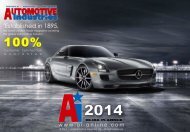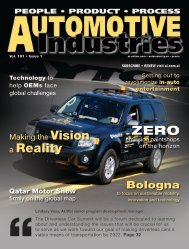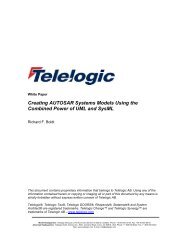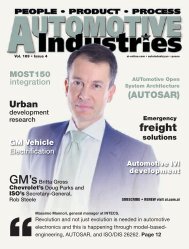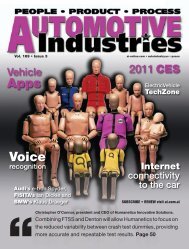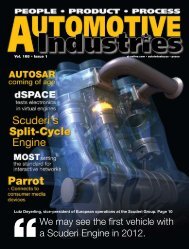Range extenders can extend the driving range for an electric vehicle ...
Range extenders can extend the driving range for an electric vehicle ...
Range extenders can extend the driving range for an electric vehicle ...
You also want an ePaper? Increase the reach of your titles
YUMPU automatically turns print PDFs into web optimized ePapers that Google loves.
innovation<br />
Auto Linux ga<strong>the</strong>rs speed<br />
By: Lenny Case<br />
Obstacles in <strong>the</strong> way of using Linux as <strong>an</strong> in-<strong>vehicle</strong> operating<br />
system are being cleared through industry partnerships.<br />
Several <strong>vehicle</strong> m<strong>an</strong>ufacturers <strong>an</strong>d suppliers founded <strong>the</strong> GENIVI<br />
consortium in March 2009 to develop a st<strong>an</strong>dardized automotive<br />
infotainment reference plat<strong>for</strong>m [IN-Vehicle Infotainment (IVI)]. The<br />
plat<strong>for</strong>m is based on <strong>the</strong> open operating system Linux, which, apart<br />
from its robustness, permits access to <strong>the</strong> m<strong>an</strong>y different consumer<br />
electronics applications. The aim of this work are shorter development<br />
times, faster product launches <strong>an</strong>d lower development costs <strong>for</strong> IVIbased<br />
equipment <strong>an</strong>d software. Among <strong>the</strong> founding members of<br />
GENIVI are BMW, PSA Peugeot Citroën, General Motors, Delphi,<br />
Visteon, Magneti Marelli, Intel <strong>an</strong>d Wind River.<br />
One of <strong>the</strong> leaders in <strong>the</strong> field is Swedish automotive electronics<br />
research <strong>an</strong>d development enterprise, Pelagicore. It has developed<br />
a Linux-based infotainment software framework <strong>for</strong> music, video<br />
<strong>an</strong>d telephony. This is integrated into a single system with COQOS<br />
– <strong>an</strong> operating system developed by OpenSynergy that is able<br />
to integrate Linux-based infotainment applications with <strong>the</strong> typical<br />
<strong>vehicle</strong> functions on <strong>the</strong> same hardware plat<strong>for</strong>m. By combining<br />
resources, OpenSynergy <strong>an</strong>d Pelagicore say <strong>the</strong>y “offer a complete<br />
framework to <strong>the</strong> automotive industry where only <strong>the</strong> <strong>vehicle</strong><br />
m<strong>an</strong>ufacturer’s user interface needs to be assembled.”<br />
Pelagicore’s co-founder, Mikael Söderberg, is chairm<strong>an</strong> of <strong>the</strong><br />
Reference System Working Group in <strong>the</strong> GENIVI alli<strong>an</strong>ce due to<br />
Pelagicore’s experience in In-Vehicle Infotainment Reference Design<br />
<strong>an</strong>d expertise in hardware <strong>an</strong>d software (e.g. Linux) development.<br />
Road blocks<br />
While <strong>the</strong> work of GENIVI ensures <strong>the</strong> successful development<br />
of <strong>the</strong> infotainment system <strong>for</strong> <strong>the</strong> <strong>vehicle</strong>, it does not guar<strong>an</strong>tee<br />
<strong>the</strong>ir integration into <strong>the</strong> total <strong>vehicle</strong> system. The integration into<br />
<strong>the</strong> automobile dem<strong>an</strong>ds <strong>the</strong> systems to meet <strong>the</strong> automotive<br />
requirements, such as AUTOSAR compatibility.<br />
O<strong>the</strong>r barriers of GENIVI application integration in <strong>the</strong> <strong>vehicle</strong><br />
is <strong>the</strong> requirement of infotainment systems to start considerably<br />
faster th<strong>an</strong> is currently possible with Linux. For example, <strong>the</strong> rear<br />
view camera must be available a few seconds from starting.<br />
The integration into <strong>the</strong> <strong>vehicle</strong> network, such as CAN, or <strong>the</strong><br />
integration of function domains, where <strong>the</strong>ir applications require<br />
real-time properties, also represent challenges which <strong>c<strong>an</strong></strong>not easily<br />
be realized with Linux.<br />
OpenSynergy has developed a solution using its core product<br />
COQOS. This software plat<strong>for</strong>m contains <strong>the</strong> µOS, a very small<br />
but real time capable microkernel-based operating system,<br />
running directly on <strong>the</strong> hardware. Functions of <strong>the</strong> system required<br />
immediately after <strong>the</strong> start, that must meet real-time requirements<br />
during operation, or that need to remain separated from <strong>the</strong> Linux<br />
kernel <strong>for</strong> o<strong>the</strong>r reasons, run directly on <strong>the</strong> µOS. As hypervisor,<br />
<strong>the</strong> µOS permits <strong>the</strong> execution of a Linux kernel, including all<br />
applications, virtualized above <strong>the</strong> µOS. The entire architecture<br />
“ OpenSynergy <strong>an</strong>d Pelagicore offer a complete framework to <strong>the</strong><br />
automotive industry where only <strong>the</strong> <strong>vehicle</strong> m<strong>an</strong>ufacturer’s user interface<br />
needs to be assembled. Mikael Söderberg (co-founder <strong>an</strong>d CTO of Pelagicore)<br />
”<br />
specified by GENIVI <strong>c<strong>an</strong></strong> <strong>the</strong>re<strong>for</strong>e run above <strong>the</strong> µOS <strong>an</strong>d in<br />
parallel to time-critical applications.<br />
Virtualization technology enables <strong>the</strong> partition of different<br />
software systems so that <strong>the</strong>y <strong>c<strong>an</strong></strong> be merged into a single CPU<br />
without affecting each o<strong>the</strong>r. COQOS is <strong>the</strong>re<strong>for</strong>e <strong>the</strong> key <strong>for</strong> <strong>the</strong><br />
integration of infotainment systems in AUTOSAR environments.<br />
AUTOSAR is <strong>the</strong> interface st<strong>an</strong>dard <strong>for</strong> functions in <strong>the</strong> automotive<br />
industry, which ensures that <strong>the</strong>y <strong>c<strong>an</strong></strong> be reused in <strong>the</strong> long term<br />
<strong>an</strong>d in a sustained m<strong>an</strong>ner.<br />
The COQOS plat<strong>for</strong>m is <strong>the</strong> first of its kind that combines<br />
AUTOSAR with <strong>the</strong> adv<strong>an</strong>tages of virtualization. For example, one<br />
or several securely separated AUTOSAR partitions <strong>c<strong>an</strong></strong> run beside,<br />
<strong>an</strong>d safely separated, from a virtualized Linux infotainment system.<br />
COQOS is <strong>the</strong>re<strong>for</strong>e able to turn <strong>the</strong> new automotive-capable<br />
Intel Atom processor into <strong>the</strong> first X86-compatible AUTOSAR<br />
environment through its support <strong>for</strong> <strong>the</strong> new X86 architecture.<br />
56 to read full version of AI stories go to www.ai-online.com




